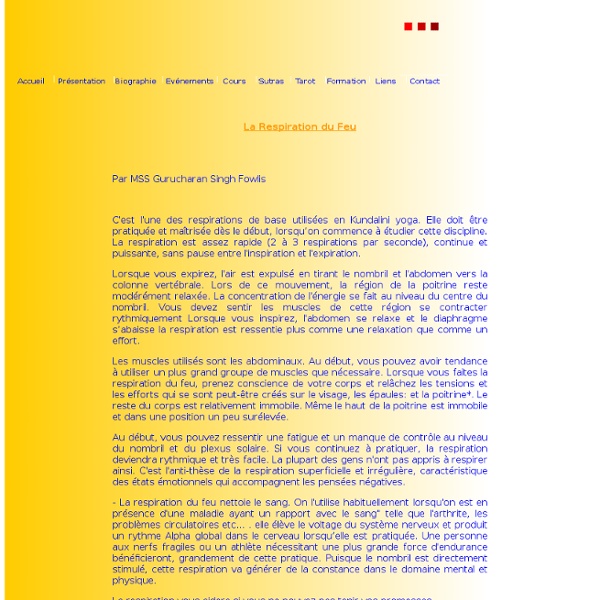Les Respirations du yoga
Ce terme ‘ pranayama ‘ constitué des mots sanscrits ‘ prana ‘ : énergie et ‘ayama’ : vitalité nous donne la direction : maintenir une bonne santé globale, incluant le mental. Par contre, il ne faut pas penser seulement en terme de dynamisme et de performance mais de gestion du souffle qui engendre la gestion du mental ( calme, puissance, équilibre ). Donc des techniques aussi bien pour dynamiser, que pour détendre, ou équilibrer. Les effets de l' allongement de la respiration La plupart des techniques de respiration visent à allonger la durée de la respiration pour augmenter la vitalité par : 1 - Oxygénation plus longue 2 - Prise d' énergie plus importante ( par les ions négatifs ) Les 3 bienfaits de la respiration consciente 1 – RÉGÉNÉRATION DU CORPS ( les ‘ vayus ‘ sont les niveaux physiologiques du ‘ prana ‘ dans le corps ) . Par ailleurs le prana c’ est aussi l’ aspect bio-électrique du corps. Les effets sur le cerveau haut de page
MISE EN PLACE
Anapanasati
Ānāpānasati is now common to Tibetan, Zen, Tiantai and Theravada Buddhism as well as Western-based mindfulness programs. Simply defined, Anapanasati is to feel the sensations caused by the movements of the breath in the body as is practiced in the context of mindfulness meditation. Origins in Buddhism[edit] Anapanasati is a core meditation practice in Theravada, Tiantai and Chan traditions of Buddhism as well as a part of many mindfulness programs. The Ānāpānasati Sutta specifically concerns mindfulness of inhalation and exhalation, as a part of paying attention to one's body in quietude, and recommends the practice of anapanasati meditation as a means of cultivating the Seven Factors of Enlightenment: sati (mindfulness), dhamma vicaya (analysis), viriya (persistence), which leads to pīti (rapture), then to passaddhi (serenity), which in turn leads to samadhi (concentration) and then to upekkhā (equanimity). The practice[edit] Traditional sources[edit] Anapanasati sutta[edit] Stages[edit]
Here Are 11 Ways to Use Yoga for the Core | MyDomaine
Sit-ups and crunches have long been the norm when it comes to strengthening the abdominal muscles, but there are alternatives to these oft-begrudged exercises. One such alternative is yoga, the unsung hero of core-strengthening exercises. According to Miami-based yoga instructor Rosario Chozas, having a good posture that is able to hold up your body in a comfortable meditative pose is at the root of traditional yoga. Additionally, because crunches and sit-ups are often done incorrectly, the core work you do when practicing yoga can end up being far more effective. 1. 2. 3. Uttanasana (Halfway Lift) 1. 2. 3. Virabhadrasana Three Variation I 1. 2. 3. 4. Virabhadrasana Three Variation II 1. 2. Uttanasana to Chaturanga Dandasana 1. 2. 3. 1. 2. Ardha Pincha Mayurasana With Leg Lifts 1. 2. Ardha Pincha Mayurasana Plank 1. 2. Vashistasana (Side Plank) 1. 2. 3. 4. Ardha Pincha Mayurasana to Adho Mukha Savasana 1. Plank to Chaturanga Dandasana 1. 2. Repeat sequence as desired.
Respiration liées aux Pratiques traditionnelles chinoises
The Art of Living Happiness Program
Home › Programs › Introductory Programs › Happiness Program Don’t Settle for Happy-ish Do you feel like happiness is often just out of reach? Find a Course Near You If you’re struggling to stay happy, calm and focused, it can be hard to break the cycle. If you feel trapped, frustrated or overwhelmed in your life... you can’t just ‘wish it away’. Through a tried and tested combination of yoga, powerful breathing exercises, meditation and practical wisdom, the Art of Living Happiness Program will help you live life the way you’ve always wanted to: Calmly, confidently, and armed with the tools you need to deal with whatever life throws at you. How the Happiness Program Helps You Create Lasting Happiness Through practical, self-empowering tools, you'll discover how to quiet the mind and be fully present and alive. Connect More Easily in All Your Relationships The program isn’t just about dealing with your internal self... Learn Practices for a Lifetime Find a Happiness Program Near You Relax Deeper
Shavasana
Level: All Levels Shavasana (sometimes written as Savasana) is perhaps the most important part of a yoga practice. It serves many purposes: physical, spiritual and philosophical. Relaxation After the exertions of the practice, Shavasana allows the body a chance to regroup and reset itself. Furthermore, the physiological benefits of deep relaxation are numerous and include(1): • a decrease in heart rate and the rate of respiration.• a decrease in blood pressure.• a decrease in muscle tension.• a decrease in metabolic rate and the consumption of oxygen.• a reduction in general anxiety.• a reduction in the number and frequency of panic attacks.• an increase in energy levels and in general productivity.• an improvement in concentration and in memory.• an increase in focus.• a decrease in fatigue, coupled with deeper and sounder sleep.• improved self-confidence. Integration An intelligent yoga practice will furnish the nervous system with a host of new neuromuscular information. Inner Focus 1. 2.
Kriya Yoga
elephant journal: Yoga, Sustainability, Politics, Spirituality.



